文章信息
- 陈琤, 张贵文, 陆滢, 徐振, 刘玉虹. 2020.
- CHEN Cheng, ZHANG Gui-wen, LU Ying, XU Zhen, LIU Yu-hong. 2020.
- 模拟升温对滨海湿地盐地碱蓬生物量及其枯落物分解影响的研究
- Studying and simulating the effects of global warming on Suaeda salsa population growth and its litter decomposition in the coastal wetland of the Laizhou Bay
- 海洋科学, 44(2): 66-75
- Marine Sciences, 44(2): 66-75.
- http://dx.doi.org/10.11759/hykx20190120003
-
文章历史
- 收稿日期:2019-01-20
- 修回日期:2019-04-01
2. 浅水湖泊综合治理与资源开发教育部重点实验室, 江苏 南京 210098;
3. 内蒙古大学, 生态与环境学院, 内蒙古 呼和浩特 010021;
4. 国电环境保护研究院有限公司, 江苏 南京 210046
2. Key Laboratory of Integrated Regulation and Resource Development on Shallow Lake of Ministry of Education, Nanjing 210098, China;
3. College of Ecology and Environment, Inner Mongolia University, Huhehaote 010021, China;
4. State Power Environmental Protection Research Institute Limited Company, Nanjing 210046, China
种群是研究群落和生态系统结构、功能、调控和动态的基础[1]。近年, 植物种群主要研究集中于种群结构、数量动态、分布格局、繁殖对策等方面[2-7]。其中, 植物生物量对形成生态系统结构和功能具有重要作用[8]。枯落物可以为植物生长提供必需的N、P以及60%其他矿物元素[9], 是生态系统物质循环与能量流动的重要环节, 在维持生态系统稳定、改善土壤理化性质和水文条件方面有不可替代的作用[10]。
盐地碱蓬(Suaeda salsa)是一种典型的稀盐型盐生植物, 在我国北方滨海盐碱地上分布广泛, 耐盐能力强, 可在盐度较高的土壤中生长, 吸收土壤盐分, 改善土质, 具有良好的经济开发潜力和生态价值[11-13]。目前对盐地碱蓬的研究主要集中在生理生态适应性, 包括种子萌发[14-15]、耐盐机理[15-17]、植株生长特征[11]等方面, 对于种群生长特征研究较少, 特别是生物量动态变化。
系统动力学(System Dynamics)是一种研究系统动态行为的学科[18], 可以根据信息的控制原理结合因果关系进行逻辑分析、描述系统结构、模拟系统的动态行为。STELLA软件(Structure thinking experi mental learning laboratory with animation)是由Isee Systems公司研发的可视化系统动力学模拟软件, 可以提供一个实现动态系统建模、仿真的集成环境[19-20]。STELLA软件构建模型独特性表现为: (1)多层次模型结构, 适宜于构建模型多层次结构; (2)简洁的操作界面和简便的操作; (3)强大的动态交互系统演示过程; (4)结构严谨的数学背景[19]。目前, STELLA软件已运用于生态学方向的研究, 国内外学者利用软件构建了多种动力学模型, 如湿地形态和生态系统演变一维模型[21]、永久性和暂时性淹水地区湿地生态系统N循环模型[22]、扩张型河口的互花米草和芦苇植被动力学模型等等[23], 但通过STELLA系统动力学软件模拟植物种群动态变化的研究很少。
因此, 本研究拟通过STELLA建模, 研究在全球变暖的条件下温度对盐地碱蓬种群生物量生长和其枯落物分解变化情况, 探究以盐地碱蓬为优势物种的滩涂湿地生态系统对全球气候变暖的响应机制, 为未来滨海湿地保护、恢复和重建提供科学依据。
1 研究区域山东昌邑国家级海洋生态特别保护区(119°20′19″~ 119°23′49″E, 37°03′07″~37°07′12″N)在2007年10月获得国家海洋局批准建立, 是中国唯一以柽柳为主的国家级海洋生态特别保护区, 属于渤海莱州湾南岸, 总面积为29.3 km2[24-25]。本次研究区域位于柽柳林防潮堤坝外部的滩涂湿地, 如图 1, 该区域属于暖温带半湿润季风区大陆性气候[27], 年降水量为580~ 660 mm, 年均蒸发量为1 764~1 859 mm, 平均气温12.9℃左右, 无霜期195~225 d[27-29]。该区域潮汐属于正规半日潮, 并时常遭受风暴潮影响[24]。土壤以潮土、盐土为主, 植被以盐地碱蓬-獐毛(Aeluropus sinensis)群落为主[30]。
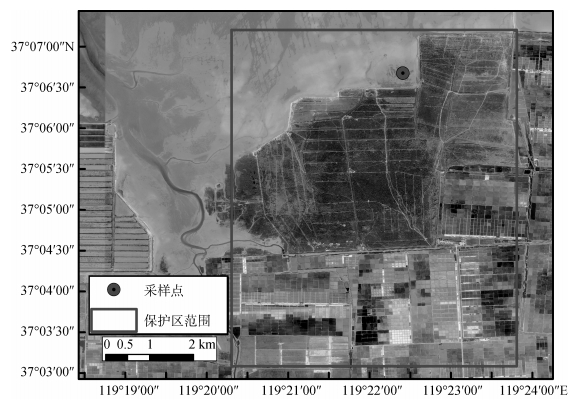 |
| 图 1 昌邑国家级海洋生态特别保护区及采样点位置 Fig. 1 The sampling site at Changyi National Marine Ecological Special Reserve |
盐地碱蓬为一年生草本植物[31], 物候期主要包括萌发期、营养生长期、孕蕾期、开花期和枯死期, 如表 1。盐地碱蓬死亡后的枯落物分解过程中, 其分解速率与温度、枯落物初始重量和分解时长相关[32-35]。一些研究表明温度既是影响枯落物分解, 也是影响微生物活性的主要因素[33]。本模型假设营养盐等外部条件不变, 且暂时未考虑周期性潮汐对枯落物的冲刷造成的质量变化, 仅考虑温度变化对枯落物分解的影响。
| 时期 | 物候期 | 生长特征 |
| 3月中下旬 | 萌发期 | 种子开始萌发, 幼苗为红色, 带两片子叶。 |
| 4月至7月 | 营养生长期 | 4月上旬开始长真叶, 步入营养生长期, 5月至7月为迅速生长期。 |
| 6月上旬至7月下旬 | 孕蕾期 | 开始孕蕾, 孕蕾期时间较长。 |
| 8月中旬 | 开花期 | 开花期开始于7月下旬, 盛放于8月中旬至9月上旬。 |
| 10月中下旬 | 果实期 | 9月中旬果实开始形成, 10月中下旬开始成熟, 成熟后易受外力脱落。 |
| 11月下旬 | 枯死期 | 11月中上旬植株开始死亡, 11月下旬几乎全部干枯死亡。 |
因此, 根据盐地碱蓬生长、死亡、水解特征, 建立植物生长过程概念模型, 如图 2所示, 表 2为模型中所涉及到的参数及其含义, 利用STELLA9.1.3软件构建植物生长与分解模型如图 3。
 |
| 图 2 盐地碱蓬种群生长和分解概念模型 Fig. 2 Conceptual model of Suaeda salsa population growth and its litter decomposition |
| 参数名称 | 参数含义 | 单位 |
| ABLP | 植物地上未死亡部分生物量 | g/m2 |
| ABDP | 植物地上部分已死亡未水解部分生物量 | g/m2 |
| UBLP | 植物地下部分生物量 | g/m2 |
| UBDP | 植物地下部分死亡未分解生物量 | g/m2 |
| ABbeingborn | 植物地上部分生物量生长量 | g/m2 |
| ABdying | 植物地上部分死亡量 | g/m2 |
| ABdecompose | 植物地上部分死亡生物量水解量 | g/m2 |
| UBbeingborn | 植物地下部分生物量生长量 | g/m2 |
| UBdying | 植物地下部分生物量死亡量 | g/m2 |
| UBdecompose | 植物地下部分死亡生物量水解量 | g/m2 |
| ABLPBR | 植物地上部分生物量生长率 | g/(m2·d) |
| ABLPDR | 植物地上部分生物量死亡率 | g/(m2·d) |
| ABDPDeR | 植物地上部分死亡生物量水解率 | g/(m2·d) |
| UBLPBR | 植物地下部分生物量生长率 | g/(m2·d) |
| UBLPDR | 植物地下部分生物量死亡率 | g/(m2·d) |
| UBDPDeR | 植物地下部分生物量死亡量水解率 | g/(m2·d) |
| Tep | 研究区域年际温度变化 | ℃ |
 |
| 图 3 盐地碱蓬种群植物生长与分解STELLA模型 Fig. 3 Model of Suaeda salsa population growth and its litter decomposition created using the STELLA software |
通过STELLA构建模型中主要生态变量见表 2及主要生态过程如下:
本研究中采用的是Olson在1963年提出的枯落物分解指数衰减模型[32], 其表达式为:
| $ \frac{{{M_t}}}{{{M_0}}} = {{\rm{e}}^{ - kt}}, $ | (1) |
公式(1)中, Mt植物枯落物在t时间的质量(g); M0为植物枯落物初始质量(g); k代表枯落物分解速率常数, k值通过文献修正得到[33]; t为分解时间(d)。
模型中盐地碱蓬枯落物水解速率使用的公式表达为:
| $ R = {{\rm{e}}^{ - kTt}}, $ | (2) |
公式(2)中, R为盐地碱蓬枯落物水解速率; T为温度函数(℃)。根据相关研究[33], 盐地碱蓬枯落物经过一年的自然分解, 剩余枯落物质量约为最初质量的1/2, 在模型动态模拟情况下, 将盐地碱蓬枯落物初始重量设置为一年中最高重量的二分之一。
模型中温度模拟根据昌邑市多年平均温度[34], 进行拟合分析, 得到拟合方程:
| $ T = 15\sin \left( {\frac{{2{\rm{ \mathsf{ π} }}}}{P}\left( {\frac{t}{{30}} - 4} \right)} \right) + 12, $ | (3) |
公式(3)中, P为周期, 此处取12, 代表一年内的12个月份; t为时间函数, 以天(d)为单位, 默认每个月天数为30, 在时间尺度上与月份衔接。
2.3 模型验证昌邑市温度数据来源于气象局网站多年实测数据, 整理成月平均气温, 用于温度气温函数拟合与验证。模拟结果说明温度模拟公式拟合度高, 可作为模型温度输入变量(如图 4, R2=0.995, p=0.000)。
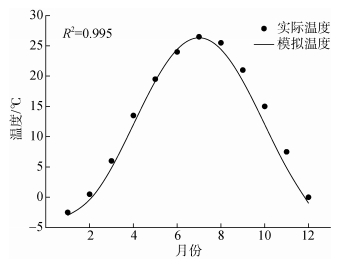 |
| 图 4 实际温度与模拟温度验证结果 Fig. 4 Comparison between the actual and simulated tempera tures |
模型中盐地碱蓬每月生物量变化数据主要来自相关研究[31]。为提高校准及验证模型精度, 于2016年8月在昌邑海洋生态特别保护区研究区域, 采集1 m×1 m样方内盐地碱蓬全部植株包括地上部分及地下部分(0.5 m深度以上所有根系), 纸袋封装, 带回实验室, 烘干, 称量干质量, 其中盐地碱蓬地上生物量为403.37 g/m2, 地下生物量为251.89 g/m2。, 文献盐地碱蓬种群地上生物量数据经过与研究区实测数据比较, 约为研究区数据的1/2, 因此, 使用2倍文献数据进行结果验证。验证结果显示, 盐地碱蓬种群地上生物量与验证数据变化趋势较一致(R2=0.932)(图 5)。盐地碱蓬地下生物量仅通过实测数据(251.89 g/m2)与地下生物量模拟值(在256 d(9月16日)为225.79 g/m2)相近进行验证。
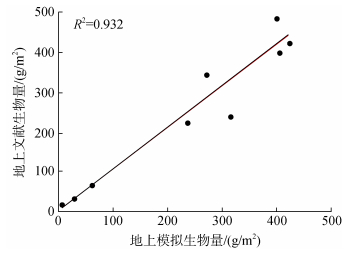 |
| 图 5 盐地碱蓬地上生物量验证结果 Fig. 5 Comparison between the actual and simulated abo ve ground biomass of Suaeda salsa |
根据图 6, 盐地碱蓬年内地上、地下生物量总体变化趋势相近:生长初期缓慢, 68~75 d开始生长, 150~200 d生物量开始急剧增加, 地上生物量在230~ 235 d达到最大值(427.48 g/m2), 而地下生物量在260~265 d达到最大值(225.79 g/m2), 300 d以后地上和地下生物量开始急速下降, 在348及338 d时, 地上生物量和地下生物量分别降至0 g/m2。
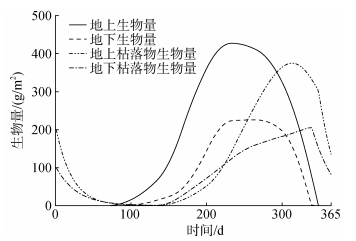 |
| 图 6 盐地碱蓬种群模拟生物量动态变化 Fig. 6 Trends in the simulated Suaeda salsa population biomass |
地上和地下枯落物(初始值分别为200 g/m2和100 g/m2)变化趋势总体一致: 0~136 d枯落物地上和地下生物量不断减少并且达到最低值(分别为0.71 g/m2和0.92 g/m2); 137~338 d地上枯落物生物量变化趋势与地上生物量相似即先增加再减少; 并且在320 d达到最大值(371.19 g/m2), 而地下枯落物生物量逐步上升并在338 d达到最大值(206.89 g/m2); 地上和地下枯落物生物量在339~365 d开始快速减少, 并且在365 d分别减少至127.69 g/m2和79.06 g/m2。
由图 7可知:盐地碱蓬地上生长率高于地下生长率并且呈现先增长再减少相似趋势。地上生长率在68 d时开始从0增长, 168d达到最大值(6.97 g/(m2·d)), 然后开始、减少, 并在333 d时达到0g/(m2·d)。地下生长率在35 d开始从0增长, 在167~200 d达到最大(2g/(m2·d)), 然后开始下降并在333 d降为0 g/(m2·d)。地上和地下部分死亡率变化趋势相似:由134 d开始, 地上和地下部分死亡率逐渐增加, 并在365 d分别达到最大值(10 g/(m2·d)和8 g/(m2·d))。
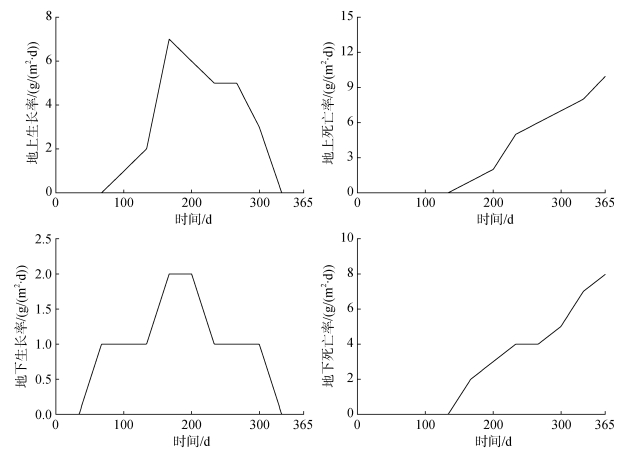 |
| 图 7 盐地碱蓬生长率与死亡率动态变化 Fig. 7 Trends in the growth rate and death rate of Suaeda salsa |
当温度提高2.5℃及5℃后, 图 8显示:地上和地下枯落物生物量变化趋势与升温前相似即先减少、在增加及后减少趋势; 升温期间(0~220 d), 地上和地下枯落物生物量几乎无显著差别, 而从220 d开始, 随着温度的升高, 地上和地下枯落物生物量增加显著。在365 d, 升温2.5℃, 地上枯落物生物量分别为194.05 g/m2和91.67 g/m2, 而升温5℃, 地上地下枯落物生物量分别为271.06 g/m2和105.31 g/m2。
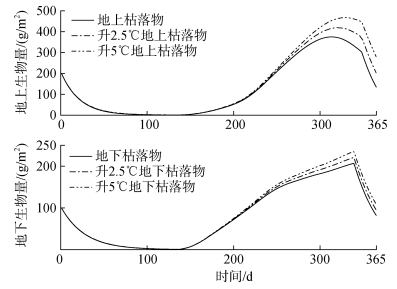 |
| 图 8 不同温度下枯落物分解动态变化 Fig. 8 Decomposition processes of Suaeda salsa litter at different temperatures |
盐地碱蓬地上分解速率与地下分解速率, 总体呈先减少后增加的相似趋势(图 9)。随着温度升高, 不同温度下地上分解速率大小关系为:未升温 > 升温2.5℃ > 升温5℃, 地下部分分解速率也存在相同现象。
 |
| 图 9 盐地碱蓬枯落物水解速率动态变化 Fig. 9 Decomposition rates of Suaeda salsa litter biomass at different temperatures |
盐地碱蓬属于稀盐盐生植物, 在高盐度、水文干扰强度大的滨海滩涂区域[30, 35]具有显著的生长优势[30, 36]。一些研究表明:在盐地碱蓬生长过程中, 盐度和水文干扰对种群初级生产力及种间密度等具有明显影响[37], 而且水文干扰主要降低了盐地碱蓬种内竞争强度, 导致一些较弱的个体死亡[37]和种内密度减小, 并且这种现象将伴随着盐地碱蓬整个生长过程。因此, 在我们模型中, 死亡率是逐渐增加的。由于土壤增温慢, 盐地碱蓬幼苗前期生长缓慢, 随着气温和地温升高, 植株营养生长急骤增加[38], 种群生物量不断增长[39-40], 而在7—8月花果期, 以繁殖生长为主, 种群生物量几乎维持不变[31, 40-41]。随着生长率下降, 盐地碱蓬植株开始枯萎, 生物量降低, 死亡率增长, 枯落物生物量增加, 并且11月底全部死亡[31, 37, 42]。我们模型过程充分体现了这些过程。一些研究还发现:生长于潮间带滩涂的盐地碱蓬, 会减少根系生物量分配, 发展叶、花为主地上生物量, 以获得更多的资源和繁殖机会[43], 我们的模型也充分体现该特征, 即盐地碱蓬地上生物量远高于地下生物量。
枯落物分解一般受到其基质质量、植被类型、温度和水分等因素影响[44]。由于研究区域受到周期性潮汐影响[45], 可以假设水分特征全年一致, 并且植被类型为单一的盐地碱蓬群落, 因此, 在模型中仅研究基质质量与温度的影响效果, 与相关研究考虑因素基本一致[33, 46]。已有研究表明, 枯落物在一年时间内自然水解的量, 为枯落物量的一半[33], 因此, 该研究模拟初始值取动态变化过程中最大值的一半, 经过一年分解后, 剩余生物量大致与初始值相同, 符合已有研究中植物枯落物分解规律(图 6)。研究表明:植物地上和地下部分枯落物分解速率变化规律相似, 分解初期, 植物还未萌发, 无死亡部分补充分解基质, 分解前一年剩余生物量[28], 随着时间推移, 温度增加, 分解率缓慢提升, 没有大量枯落物补充, 分解率逐步下降, 进入9月后, 随着盐地碱蓬枯落物生物量增加, 分解基质质量增加, 分解速率加快, 盐地碱蓬枯落物生物量开始减少。我们模拟分解过程充分体现了枯落物分解规律。
如果模拟温度上升2.5℃和5℃, 我们模拟结果显示地上和地下分解率下降, 枯落物生物量减少较慢。原因可能是温度过高, 不利于各层土壤微生物活动。一些研究发现, 含碳养分分解的最大速度在一定的温度之间, 在最适点范围(一般为5~30℃), 随温度升高, 微生物活性增加, 加速有机物的分解[47]。我们的模型升温后, 月平均最高温达29.5℃和32℃, 超过了最适温度范围。剩余枯落物生物量随着温度升高增加, 枯落物中更多有机质未分解, 碳释放量减少, 在全球变暖的大环境下滨海湿地将从碳源转变为碳汇[48]。
综上所述, STELLA动力学软件能够有效模拟盐地碱蓬种群动态变化特征, 并且研究结果揭示了, 在全球气候变暖条件下, 滨海湿地植物生长过程及其枯落物分解过程的产物对碳源及碳汇的影响程度。
5 结论本研究利用系统动力学软件STELLA构建盐地碱蓬群落的生长与分解模型, 模拟不同温度环境下, 盐地碱蓬枯落物分解特征。随着温度升高, 枯落物分解速率减弱, 枯落物分解量显著降低, 主要由于温度过高, 不利于各层土壤微生物分解活动。因此, 在全球变暖背景下, 枯落物分解特征研究有助于深入了解滨海湿地植被在碳源汇过程中的作用。
| [1] |
陈银萍.祁连山青海云杉种群结构组建稳定性机制研究[D].兰州: 甘肃农业大学, 2000. Chen Yinping. A preliminary study on the mechanism of maintaining structure stability of Picea crassifolia population in the Qilian Mountains[D]. Lanzhou: Gansu Agricultural University, 2000. |
| [2] |
韩路, 王海珍, 周正立, 等. 塔里木河上、中游胡杨种群结构与统计分析[J]. 生态学报, 2007, 27(4): 1315-1322. Han Lu, Wang Haizhen, Zhou Zhengli, et al. Population structure and demography of Populus euphraticu in upper and middle reaches of Tarmi River[J]. Acta Ecologica Sinica, 2007, 27(4): 1315-1322. DOI:10.3321/j.issn:1000-0933.2007.04.008 |
| [3] |
唐建维, 施济普, 张光明, 等. 西双版纳不同斑块望天树种群的密度、结构和生物量[J]. 植物生态学报, 2008, 32(1): 40-54. Tang Jianwei, Shi Jipu, Zhang Guangming, et al. Density, structure and biomass of Parashorea chinensis population in different patches in Xishuangbanna, SW China[J]. Journal of Plant Ecology(Chinese Version), 2008, 32(1): 40-54. DOI:10.3773/j.issn.1005-264x.2008.01.005 |
| [4] |
金晓明, 兰雪, 官庆新, 等. 不同密度下羊草种群的无性繁殖对策[J]. 草地学报, 2017, 25(4): 845-850. Jin Xiaoming, Lan Xue, Guan Qingxin, et al. The strategy of asexual reproduction for population of Leymus chinensis under different densities[J]. Acta Agrestia Sinica, 2017, 25(4): 845-850. |
| [5] |
李文达, 王国梁, 刘国彬, 等. N添加对白羊草生长及种群特征的影响[J]. 水土保持通报, 2016, 36(1): 175-178. Li Wenda, Wang Guoliang, Liu Guobin, et al. Effects of nitrogen addition on growth and propagation of Bothriochloa ischaemum population[J]. Bulletin of Soil and Water Conservation, 2016, 36(1): 175-178. |
| [6] |
Eid E M, Youssef M S G, Shaltout K H. Population characteristics of giant reed (Arundo donax L.) in cultivated and naturalized habitats[J]. Aquatic Botany, 2016, 129: 1-8. DOI:10.1016/j.aquabot.2015.11.001 |
| [7] |
Saatkamp A, Affre L, Dutoit T, et al. Plant traits and population characteristics predict extinctions in a long-term survey of Mediterranean annual plants[J]. Biodiversity and Conservation, 2018, 27: 2527-2540. DOI:10.1007/s10531-018-1551-9 |
| [8] |
郭娜, 刘剑秋. 植物生物量研究概述(综述)[J]. 亚热带植物科学, 2011, 40(2): 83-88. Guo Na, Liu Jianqiu. A review or research on plant biomass[J]. Subtropical Plant Science, 2011, 40(2): 83-88. DOI:10.3969/j.issn.1009-7791.2011.02.024 |
| [9] |
戴巍, 赵科理, 高智群, 等. 典型亚热带森林生态系统碳密度及储量空间变异特征[J]. 生态学报, 2017, 37(22): 7528-7538. Dai Wei, Zhao Keli, Gao Zhiqun, et al. Spatial variation characteristics of carbon density and storage in forest ecosystems in a typical subtropical region[J]. Acta Ecologica Sinica, 2017, 37(22): 7528-7538. |
| [10] |
魏文俊, 尤文忠, 赵刚, 等. 退化柞蚕林封育对枯落物和表层土壤持水效能的影响[J]. 生态学报, 2016, 36(3): 721-728. Wei Wenjun, You Wenzhong, Zhao Gang, et al. Effects of enclosure and recovery for degraded Tussah-feeding oak forests on litter and surface soil water holding capacity characteristics[J]. Acta Ecologica Sinica, 2016, 36(3): 721-728. |
| [11] |
黄玮, 李志刚, 乔海龙, 等. 旱盐互作对盐地碱蓬生长及其渗透调节物质的影响[J]. 中国生态农业学报, 2008, 16(1): 173-178. Huang Wei, Li Zhigang, Qiao Hailong, et al. Interactive effect of sodium chloride and drought on growth and osmotic of Suacda salsa[J]. Chinese Journal of EcoAgriculture, 2008, 16(1): 173-178. |
| [12] |
杨艳, 许峻模, 潘良浩. 北部湾盐沼茳芏盐沼湿地土壤-植物系统重金属污染评价[J]. 生态环境学报, 2017, 26(11): 1969-1976. Yang Yan, Xu Junmo, Pan Lianghao. Assessment of heavy mental contamination in the soil-plant system of Cyperus malaccensis salt marsh wetland in Beibu Gulf[J]. Ecology and Environmental Sciences, 2017, 26(11): 1969-1976. |
| [13] |
张立宾, 徐化凌, 赵庚星. 碱蓬的耐盐能力及其对滨海盐渍土的改良效果[J]. 土壤, 2007, 39(2): 310-313. Zhang Libin, Xu Hualing, Zhao Gengxing. Salt tolerance of Suaeda salsa and its soil ameliorating effect on coastal saline soil[J]. Soils, 2007, 39(2): 310-313. |
| [14] |
李劲松, 郭凯, 李晓光, 等. 模拟干旱和盐碱胁迫对碱蓬、盐地碱蓬种子萌发的影响[J]. 中国生态农业学报, 2018, 26(7): 1011-1018. Li Jingsong, Guo Kai, Li Xiaoguang, et al. Effects of PEG, NaCl and Na2CO3 stresses on Suaeda glauca and Suaeda salsa seed germination[J]. Chinese Journal of Eco-Agriculture, 2018, 26(7): 1011-1018. |
| [15] |
卫晓雅, 合展, 赵瑞华, 等. 盐地碱蓬二型性种子的萌发和休眠及生态适应特性[J]. 西北植物学报, 2017, 37(4): 758-766. Wei Xiaoya, He Zhan, Zhao Ruihua, et al. Ecological adaptation in dormancy and germination of dimorphic seeds of Suaeda salsa[J]. Acta Botanica Boreali-Occidentalia Sinica, 2017, 37(4): 758-766. |
| [16] |
綦翠华, 韩宁, 王宝山. 不同盐处理对盐地碱蓬幼苗肉质化的影响[J]. 植物学报, 2005, 22(2): 175-182. Qi Cuihua, Han Ning, Wang Baoshan, et al. Effect of different salt treatments on succulence of Suaeda salsa seedlings[J]. Chinese Bulletin of Botany, 2005, 22(2): 175-182. |
| [17] |
段德玉, 刘小京, 李存桢, 等. N素营养对NaCl胁迫下盐地碱蓬幼苗生长及渗透调节物质变化的影响[J]. 草业学报, 2005, 14(1): 63-68. Duan Deyu, Liu Xiaojing, Li Cunzhen, et al. The effects of nitrogen on the growth and solutes of halophyte Suaeda salsa seedlings under the stress of NaCl[J]. Acta Prataculturae Sinica, 2005, 14(1): 63-68. DOI:10.3321/j.issn:1004-5759.2005.01.012 |
| [18] |
王其藩. 系统动力学(修订版)[M]. 上海: 上海财经大学出版社, 2009. Wang Qifan. System Dynamics (Revised)[M]. Shanghai: Shanghai University of Finance & Economics Press, 2009. |
| [19] |
张波, 虞朝晖, 孙强, 等. 系统动力学简介及其相关软件综述[J]. 环境与可持续发展, 2010, 35(2): 1-4. Zhang Bo, Yu Zhaohui, Sun Qiang, et al. A brief introduction to system dynamics and its related software[J]. Environment and Sustainable Development, 2010, 35(2): 1-4. DOI:10.3969/j.issn.1673-288X.2010.02.001 |
| [20] |
石红雁, 许纯新, 付连宇. 基于SIMULINK的液压系统动态仿真[J]. 农业机械学报, 2000, 31(5): 94-96. Shi Hongyan, Xu Chunxin, Fu Lianyu. Study on dynamical simulation of hydraulic system based on SIMULINK[J]. Transactions of the Chinese Society of Agricultural Machinery, 2000, 31(5): 94-96. DOI:10.3969/j.issn.1000-1298.2000.05.028 |
| [21] |
Peijl M J V D, Verhoeven J T A. A model of carbon, nitrogen and phosphorus dynamics and their interactions in river marginal wetlands[J]. Ecological Modelling, 1999, 118: 95-130. DOI:10.1016/S0304-3800(99)00014-9 |
| [22] |
Hes E M A, Niu R, Dam A A V. A simulation model for nitrogen cycling in natural rooted papyrus wetlands in East Africa[J]. Wetlands Ecology and Management, 2014, 22: 157-176. DOI:10.1007/s11273-014-9336-8 |
| [23] |
Wang Q, J rgensen S E, Lu J, et al. A model of vegetation dynamics of Spartina alterniflora, and Phragmites australis, in an expanding estuarine wetland:Biological interactions and sedimentary effects[J]. Ecological Modelling, 2013, 250: 195-204. DOI:10.1016/j.ecolmodel.2012.09.024 |
| [24] |
冷宇, 张守本, 刘一霆, 等. 昌邑海洋生态特别保护区潮间带大型底栖动物时空分布特征[J]. 中国环境监测, 2014, 30(2): 164-169. Leng Yu, Zhang Shouben, Liu Yiting, et al. Spatial distribution and seasonal variation of macrobenthos in intertidal flat of Changyi Marine Ecological Special Protection Area[J]. Environmental Monitoring in China, 2014, 30(2): 164-169. DOI:10.3969/j.issn.1002-6002.2014.02.032 |
| [25] |
夏江宝, 孔雪华, 陆兆华, 等. 滨海湿地不同密度柽柳林土壤调蓄水功能[J]. 水科学进展, 2012, 23(5): 628-634. Xia Jiangbao, Kong Xuehua, Lu Zhaohua, et al. Capacity of soil water storage and regulation under different density forests of Tamarix chinensis Lourin coastal wetland[J]. Advances in Water Science, 2012, 23(5): 628-634. |
| [26] |
刘潇, 冯秀丽, 刘杰. 港口工程影响下莱州湾西南侧海域水动力演化特征[J]. 海洋科学, 2016, 40(3): 138-145. Liu Xiao, Feng Xiuli, Liu Jie. Hydrodynamic evolution characteristics of southwest Laizhou Bay under the effect of port construction[J]. Marine Sciences, 2016, 40(3): 138-145. |
| [27] |
荣戗戗, 刘京涛, 夏江宝, 等. 莱州湾湿地柽柳叶片N、P生态化学计量学特征[J]. 生态学杂志, 2012, 31(12): 3032-3037. Rong Qiangqiang, Liu Jingtao, Xia Jiangbao, et al. Leaf N and P stoichiometry of Tamarix chinensis L. in Laizhou Bay wetland, Shandong Province of East China[J]. Chinese Journal of Ecology, 2012, 31(12): 3032-3037. |
| [28] |
汤爱坤, 刘汝海, 许廖奇, 等. 昌邑海洋生态特别保护区土壤养分的空间异质性与植物群落的分布[J]. 水土保持通报, 2011, 31(3): 88-93. Tang Aikun, Liu Ruhai, Xu Liaoqi, et al. Spatial heterogeneity of soil nutrients and distribution of plant community in Changyi Marine Ecological Special Protection Area[J]. Bulletin of Soil and Water Conservation, 2011, 31(3): 88-93. |
| [29] |
刘莹, 姜锡仁, 王兴, 等. 莱州湾南岸海水入侵变化趋势及成因分析[J]. 海洋科学, 2018, 42(2): 108-117. Liu Ying, Jiang Xiren, Wang Xing, et al. The trend and influencing factors of seawater intrusion in the south coast of the Laizhou Bay[J]. Marine Sciences, 2018, 42(2): 108-117. |
| [30] |
陈琤, 刘玉虹, 陆滢, 等. 防潮堤坝对山东昌邑滨海湿地植物及土壤性质的影响分析[J]. 海洋科学, 2017, 41(5): 50-58. Chen Cheng, Liu Yuhong, Lu Ying, et al. Effects of tide dyke on plants and soil properties of coastal wetlands in Changyi, Shandong[J]. Marine Sciences, 2017, 41(5): 50-58. |
| [31] |
宋百敏.黄河三角洲盐地碱蓬(Suaeda salsa)种群生态学研究[D].济南: 山东大学, 2002. Song Baimin. Study on the population ecology of Suaeda salsa in Yellow River Delta[D]. Jinan: Shandong University, 2002. |
| [32] |
Olson J S. Energy storage and the balance of producers and decomposers in ecological systems[J]. Ecology, 1963, 44(2): 322-331. DOI:10.2307/1932179 |
| [33] |
巩崇贤.大型水生植物腐烂分解的研究[D].武汉: 华中师范大学, 2014. Gong Chongxian. A study on the decomposition of the aquatic macrophytes[D]. Wuhan: Central China Normal University, 2014. |
| [34] |
Liu Y, Wang L, Liu H, et al. Comparison of carbon sequestration ability and effect of elevation in fenced wetland plant communities of the Xilin River floodplains:A model case study[J]. River Research & Applications, 2015, 31(7): 858-866. |
| [35] |
张绪良.莱州湾南岸滨海湿地的退化及其生态恢复、重建研究[D].青岛: 中国海洋大学, 2006. Zhang Xuliang. Research on restoration and rehabilitation of degraded coastal wetlands in the south Laizhou Bay[D]. Qingdao: Ocean University of China, 2006. |
| [36] |
赵勐, 范海, 赵可夫. NaCl、KC1和NaNO3对盐地碱蓬生长以及植物体内离子组成和分布的效应[J]. 植物生理学报, 2008, 44(2): 263-267. Zhao Meng, Fan Hai, Zhao Kefu. Effects of NaCl, KCl and NaNO3 on the growth and ion composition and distribution in Suaeda salsa (L.) Pall[J]. Plant Physiology Communications, 2008, 44(2): 263-267. |
| [37] |
刘雪华.盐分和水文干扰对盐地碱蓬个体及种群的影响[D].济南: 山东师范大学, 2016. Liu Xuehua. Effects of salinity and hydrological interference on individuals and populations of Suaeda salsa[D]. Jinan: Shandong Normal University, 2016. |
| [38] |
李洪山, 李慈厚, 申玉香, 等. 滩涂盐地碱蓬生态分布特点与生长竞争性研究[J]. 江苏农业科学, 2009, 37(2): 296-298. Li Hongshan, Li Cihou, Shen Yuxiang, et al. Study on the ecological distribution characteristics and growth competition of Suaeda salsa[J]. Hans Journal of Agricultural Sciences, 2009, 37(2): 296-298. DOI:10.3969/j.issn.1002-1302.2009.02.125 |
| [39] |
王建良, 赵成章, 张伟涛, 等. 秦王川湿地盐角草和盐地碱蓬种群的空间格局及其关联性[J]. 生态学杂志, 2017, 36(9): 2494-2500. Wang Jianliang, Zhao Chengzhang, Zhang Weitao, et al. Spatial pattern and interspecific association of Salicornia europaea and Suaeda salsa in Qinwangchuan wetland[J]. Chinese Journal of Ecology, 2017, 36(9): 2494-2500. |
| [40] |
钱兵, 顾克余, 赫明涛, 等. 盐地碱蓬的生态生物学特性及栽培技术[J]. 中国野生植物资源, 2000, 19(6): 62-63. Qian Bing, Gu Keyu, He Mingtao, et al. Ecological and biological characteristics and cultivation techniques of Suaeda salsa[J]. Chinese Wild Plant Resources, 2000, 19(6): 62-63. |
| [41] |
左明, 张士华, 刘志国, 等. 莱州湾西岸盐渍土中耐盐景观植物生长规律及脱盐效果研究[J]. 北方园艺, 2014(11): 59-62. Zuo Ming, Zhang Shihua, Liu Zhiguo, et al. Study on growth rhythm and desalination effect of landscape halophytes in saline soils of West Laizhou Bay[J]. Northern Horticulture, 2014(11): 59-62. |
| [42] |
毛培利, 成文连, 刘玉虹, 等. 滨海不同生境下盐地碱蓬生物量分配特征研究[J]. 生态环境学报, 2011, 20(8-9): 1214-1220. Mao Peili, Cheng Wenlian, Liu Yuhong, et al. Biomass allocation in Suaeda salsa population in different habitats of coastal zone[J]. Ecology and Environmental Sciences, 2011, 20(8-9): 1214-1220. |
| [43] |
吴勇泉.黄河三角洲湿地典型挺水植物对水盐环境的响应机制[D].武汉: 华中科技大学, 2009. Wu Yongquan. Response mechanisms of typical emerged plants to salt and water environment in wetlands of the Yellow River Delta[D]. Wuhan: Huazhong University of Science and Technology, 2009. |
| [44] |
陈婷, 郗敏, 孔范龙, 等. 枯落物分解及其影响因素[J]. 生态学杂志, 2016, 35(7): 1927-1935. Chen Ting, Xi Min, Kong Fanlong, et al. A review on litter decomposition and influence factors[J]. Chinese Journal of Ecology, 2016, 35(7): 1927-1935. |
| [45] |
张绪良, 张朝晖, 徐宗军, 等. 莱州湾南岸滨海湿地的景观格局变化及累积环境效应[J]. 生态学杂志, 2009, 28(12): 2437-2443. Zhang Xuliang, Zhang Zhaohui, Xu Zongjun, et al. Landscape pattern change and its cumulative environmental effects of coastal wetlands in southern Laizhou Bay[J]. Chinese Journal of Ecology, 2009, 28(12): 2437-2443. |
| [46] |
周俊丽, 吴莹, 张经, 等. 长江口潮滩先锋植物藨草腐烂分解过程研究[J]. 海洋科学进展, 2006, 24(1): 44-50. Zhou Junli, Wu Ying, Zhang Jing, et al. Study on putrefaction and decomposition process of Scirpus triqueteron the Changjiang Estuary Tidal Flat[J]. Advances in Marine Science, 2006, 24(1): 44-50. DOI:10.3969/j.issn.1671-6647.2006.01.006 |
| [47] |
Marschner B, BredowA. Temperature effects on release and ecologically relevant properties of dissolved organic carbon in sterilized and biologically active soil samples[J]. Soil Biology and Biochemistry, 2002, 34(4): 459-466. DOI:10.1016/S0038-0717(01)00203-6 |
| [48] |
曹磊.山东半岛北部典型滨海湿地碳的沉积与埋藏[D].青岛: 中国科学院海洋研究所, 2014. Cao Lei. Carbon deposition and burial in typical coastal wetlands of the northern Shandong peninsula[D]. Qingdao: Institute of Oceanology, Chinese Academy of Sciences, 2014. |
 2020, Vol. 44
2020, Vol. 44


